December 2009
It was a tuff decision this month. There were no collectors
meetings or other main events, only the monthly flea market in Utrecht. But that
brought us -besides some nice decks to trade- an unusual find: a hand made deck
with special designs on the courts. Although there are 4 court cards missing the
rest of the designs were so well done, that we treasure our first
"hand-made" deck so much that it was in competition until the last
possible moment. But we've decided to show that deck in the "Art&Cards" xpo,
so it would get exposure on our site anyway.
This month's deck was a gift! It's common knowledge
among our friends, that we collect playing cards. Most of our friends don't go
to flea-markets or antique shops, but every once in a while they bring us a
deck,
usually souvenir decks from a vacation. But there are a few friends that
frequently visit a flea-market in search of their collectibles. Frank Vos and
Oscar Bodelier are interested in completely different things than playing cards,
but they know that we're always looking for decks by the Dutch manufacturer
"Speelkaartenfabriek Nederland" and we sort of gave them a crash
course in recognizing these decks. So sometimes they take along a deck for us
and of course for them we take stuff along that they collect. But this month
their gift was a rather special deck for us.
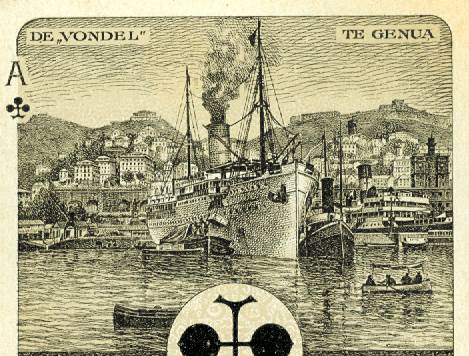 |
We have
the pattern in our collection. It's called "Dietsche Kaart"
and it usually comes with a set of aces, illustrated with emblem-like
designs. This deck however was a special edition, made for the S.M.N. (Stoomvaart
Maatschappij Nederland)
shipping line. It comes with a special set of aces, which show the ports
of the shipping line. In a later S.M.N. edition and with a different
pattern on the courts, this set of aces is also used, but with a
different scene on the Ace of Clubs and the Ace of Hearts. |
|
The shown
scenes here make the difference on these aces and show the SS
Vondel in the ports of Genua (Genoa) and Amsterdam.
The SS
Vondel was built for the S.M.N. lines in 1907. It was originally a
completely white vessel, but in 1912 the hull was painted black up to
the first row of port-holes. |
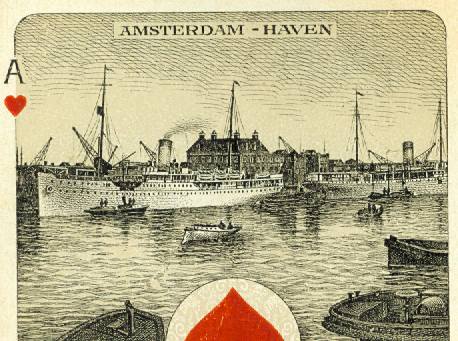 |
It's obvious that these images were created before 1912.
And one could easily believe that this set of aces was created to celebrate the
maiden voyage of the SS Vondel, but.....the manufacturer of the deck, the Nederlandse
Speelkaarten Fabriek
(NSF, a predecessor of the Speelkaartenfabriek Nederland,
in short SN), wasn't founded and operational until 1909. So, that dates the
deck as made between 1909 and 1912 and it's likely that the date is closer
to 1909 than to 1912.
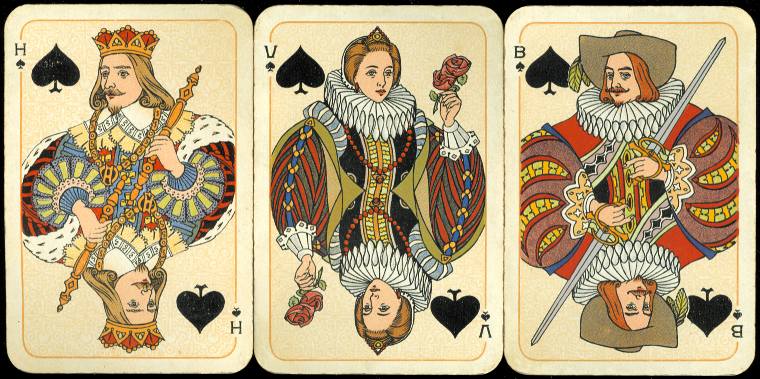
The Dutch word "Dietsch" was used to describe the Middle
Dutch language, which consisted of a number of West Germanic dialects and was
spoken -roughly between 1100 and 1500 AC- in a region that not only included the Netherlands, but also the Flemish
part of Belgium and the top of North-Western part of France. The word "Dietsch"
disappeared from common speech in the Netherlands after it was used as reference
to a greater German/Dutch state by collaborating Dutch and
Flemish nationalists in their propaganda during WW II, when the Germans had
occupied the Netherlands and Belgium. One could say that it had become
politically incorrect.
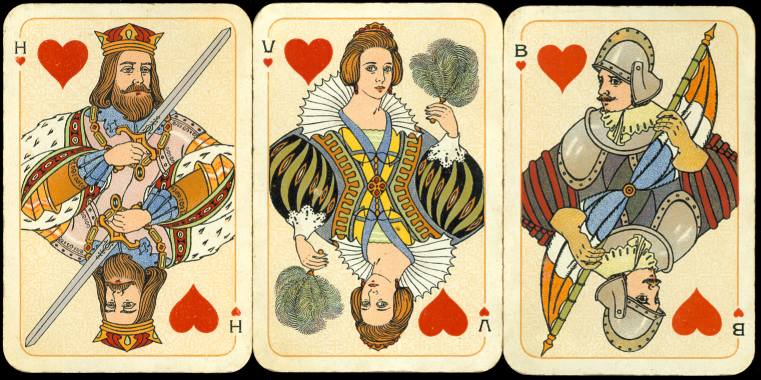
Although the designs of the courts do not bear resemblance to
any of the Dutch royalty, there are a few details that hint towards the royal
family. Our national flag is the red, white and blue, but in the flag on the Jack of Hearts the color orange is
used, instead of
red. It could refer to the House of Orange, of which all our royals are
descendants, and their "orange, blanche, blue" colors. A second remark
can be made about the fans on the Queens of Hearts and Clubs. The feather fans
became fashionable around 1900 and our Queens Emma and Wilhelmina were avid
collectors of fans. They owned a few spectacular feather fans, so these depicted
fans may hint to them and their hobby.
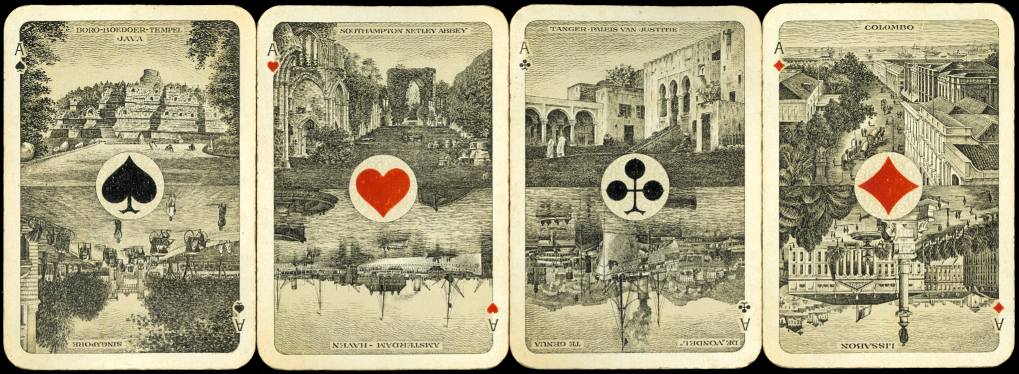
The S.M.N.'s route to the Far East is depicted on the aces.
It started in Amsterdam and stopped in Southampton, Lisbon, Tanger, Genoa,
Colombo and Singapore, before reaching Java.
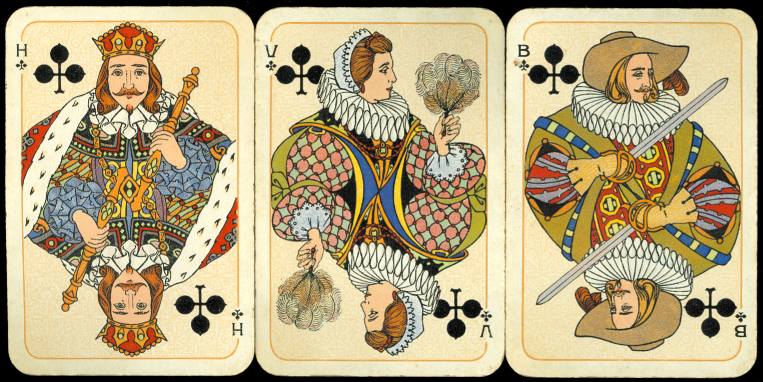
One of the characteristics of the NSF cards is that the
indices are printed in black in the red suits too. Another is the flat bottom of
the V (Vrouw = Lady) on the Queens. When SN took over the NSF and their stock,
the old NSF indices remained in the SN editions until the stock was sold out.
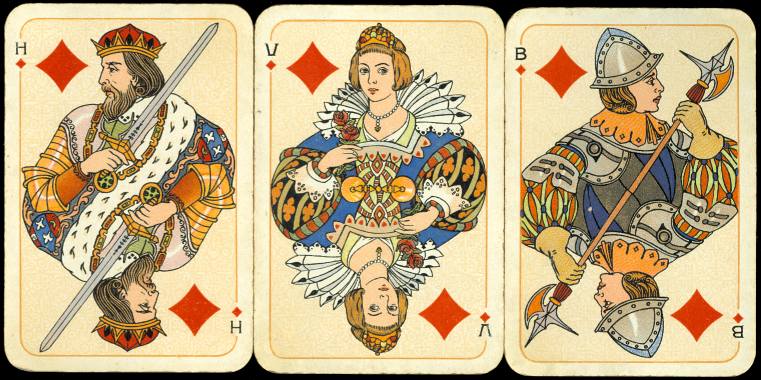
The back design has the S.M.N. logo and on the box the deck
is titled "Salonkaart Whist", "merk (mark) S.M.N".
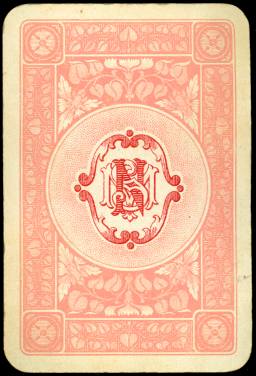
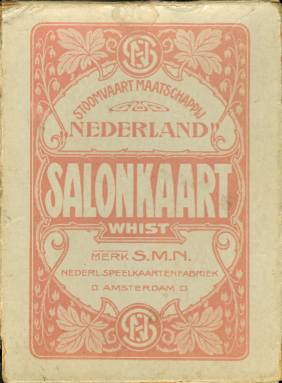

The box is made to hold 52 cards and usually the decks consists of 52
cards, as no joker was ever issued with this deck. However, our deck was cut
down by the previous owner for playing "klaverjas", a Dutch game that only requires 32 cards.
But it is still a very nice addition to our SN collection.
BACK TO PRESENT MONTH









